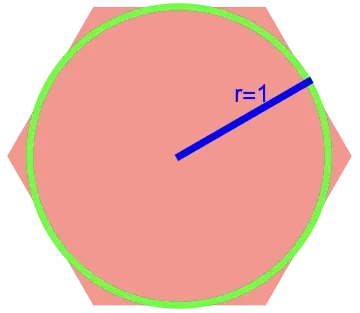Without calculator, how to prove that $2 \sqrt{3} > \pi$?
The level is baccalauréat grade. I confirm it's not a school exercise at all, as I left school like 35 years ago.
Without calculator, how to prove that $2 \sqrt{3} > \pi$?
The level is baccalauréat grade. I confirm it's not a school exercise at all, as I left school like 35 years ago.

(Credit to David G. Stork for the image).
I am showing the area-based argument explicitly because it seems that the other answers rely on a perimeter-based argument (which I find unconvincing without a rigorous proof). In contrast, it is quite easy to conclude by simple inspection that the circumscribed hexagon has a larger area than the inscribed circle.
The area of the circle is clearly simply $\pi$.
The hexagon can be decomposed into six congruent equilateral triangles. The height of each is $1$. The base can be computed with trigonometry as $(2)\tan\frac{\pi}{6} = \frac 2{\sqrt 3}$. Hence the area of a single triangle is $\frac 12 (1)(\frac 2{\sqrt 3})= \frac 1{\sqrt 3}$. The area of the hexagon is therefore $\frac 6{\sqrt 3} = 2\sqrt 3$.
This allows us to immediately conclude $2\sqrt 3> \pi$ as required.
By a geometric argument just consider a circle inscribed in an hexagon and compare the two perimeters to obtain
$$3 \cdot \frac23 \sqrt 3 > \pi \cdot 1 \iff 2\sqrt 3>\pi$$
We know that $\tan x \gt x$ for $x\in (0,\frac{\pi}{2})$. So, when $x = \frac{\pi}{6}$
$\tan \frac{\pi}{6} \gt \frac{\pi}{6} \implies \frac{1}{\sqrt3} \gt \frac{\pi}{6} \implies 2\sqrt3 \gt \pi$
Let us consider an equilateral triangle of side length $a$. The area of equilateral triangle is $$A_e=\frac{\sqrt3a^2}{4}$$ Let there be incentre in the triangle. Incentre Radius $$r=\frac{a}{2\sqrt3}$$ Area of circle $$A_c=\pi r^2 = \frac{\pi a^2}{12}$$ Since $$A_e>A_c$$ $$\frac{\sqrt3a^2}{4} > \frac{\pi a^2}{12}$$ $$3\sqrt3>\pi$$
If you consider a circle in a square, then $$a^2>\pi a^2/4$$ $$4>\pi$$
If you consider a circle in hexagon then $$\frac{3\sqrt3 \cdot a^2} 2 > \pi\left(\frac{\sqrt3}2\cdot a \right)^2$$ $$2\sqrt3>\pi.$$
In general, incentre Radius of a circle inscribed in a polygon of side $n$ and length $a$ is $$\frac{a}{2\tan{180^\circ/n}}$$
Noting the fact that $$\tan\theta \geq \theta~~\forall x\in\left[0,\frac\pi2\right)$$ with equality for $x=0$
we have $$\tan\frac\pi6>\frac\pi6$$ $$\implies \frac{\sqrt 3}3 >\frac\pi6$$ $$\implies \sqrt3 >\frac\pi2$$ $$\implies\boxed{2\sqrt3>\pi}$$